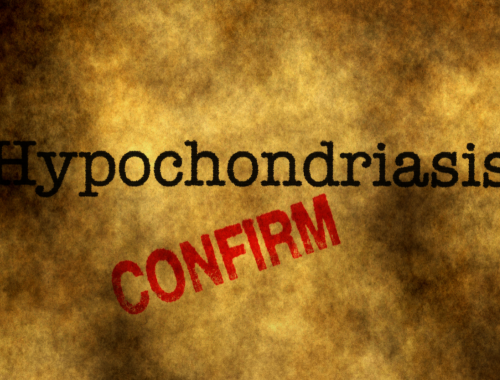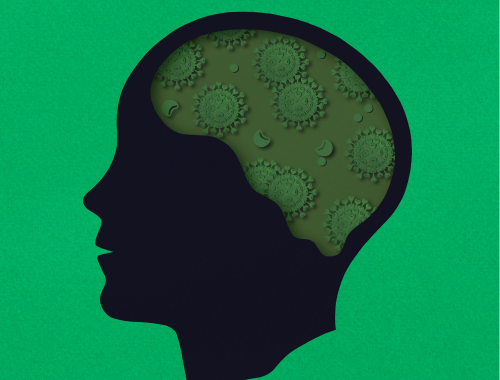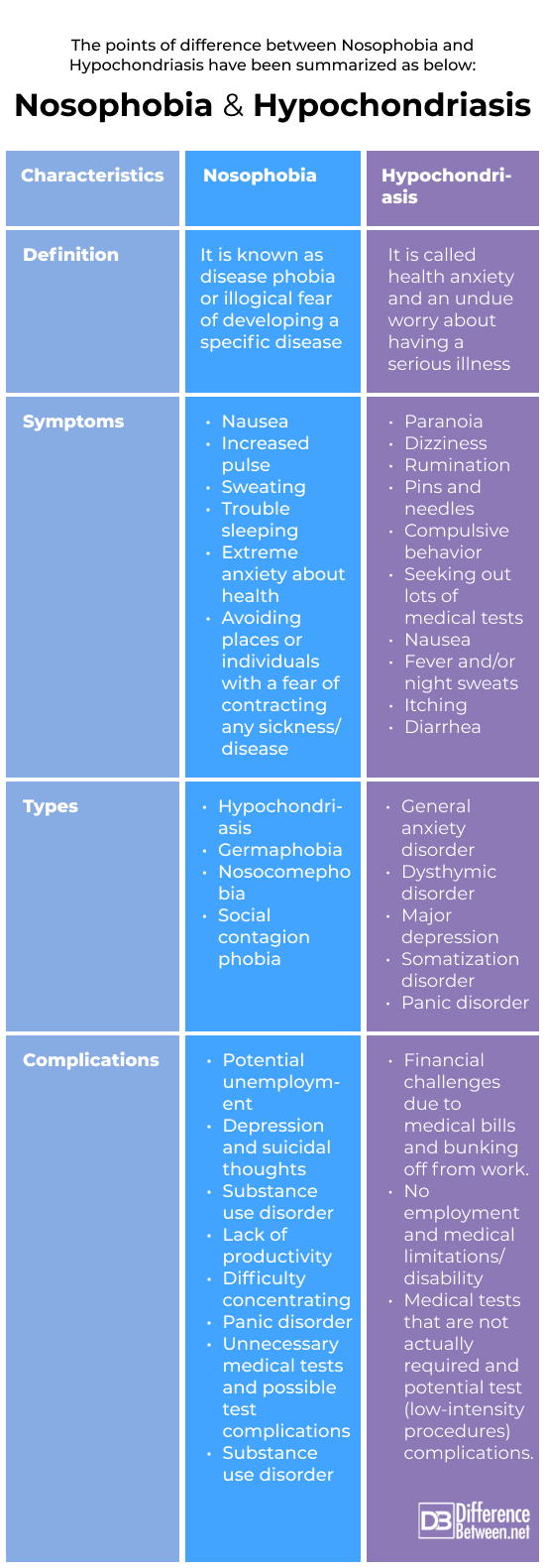Difference Between Nosophobia and Hypochondriasis

Nosophobia is the persistent, illogical fear of developing a chronic, frequently fatal illness, such as cancer (malignancy) or AIDS – Acquired Immuno Deficiency Syndrome. The disease anxiety disorder – Obsession with the idea of having a serious but undiagnosed medical condition (hypochondria) that makes you worry about all illnesses/sicknesses is different from nosophobia.

Similarity
People suffering from Nosophobia and Hypochondriasis both share the overarching feelings of extreme fear and intense worry.
Nosophobia
The uncontrollable and persistent worry of developing a major medical condition is termed as nosophobia, or disease anxiety disorder.
You can experience a new bodily sensation and interpret it as an illness. If you suffer from a disorder of illness anxiety, you could frequently believe that your illness is serious.
Hypochondriasis
An overwhelming fear of becoming extremely ill or having a serious illness is known as illness anxiety disorder, also referred to as hypochondriasis or health anxiety. You could be symptom-free physically. You can also think that common bodily sensations or minor symptoms indicate a major medical issue, despite the fact that a careful physical examination reveals no such thing.
Difference between Nosophobia and Hypochondriasis
Definition
Nosophobia
Uncontrollable, irrational and persistent fear of developing a disease
Hypochondriasis
A chronic mental illness which involves intense fear of having a serious illness and stress that tiny symptoms indicate something serious.
Causes
Nosophobia
Nosophobia (disease phobia or illness anxiety disorder) can be brought on by traumatic (distressing) medical experiences from the past, media exposure to epidemics (increase of a specific illness within a community or region) or other significant health issues, or skimming through about sicknesses/medical diseases at work or school.
Hypochondriasis
An individual who experienced a childhood sickness (illness in early years of life) or who had a sibling (brother or sister) who experienced a childhood illness may develop hypochondria (health anxiety). It could be connected to a different mental illness/disease, such as anxiety or obsessive-compulsive disorder (OCD). One of these additional illnesses may lead to or be a symptom of hypochondriasis.
Ways to overcome
Nosophobia
- Cognitive behavioral therapy (CBT)
- Exposure therapy – exposure to news stories and awareness about illnesses and outbreaks of diseases
- Hypnotherapy – utilization of guided relaxation techniques to change your outlook of an illness and health risks associated to you.
- Medications
Hypochondriasis
- Psychotherapy – offers you skills to manage learn skills to manage illness anxiety disorder
- Medications – Antidepressants, like serotonin reuptake inhibitors (SSRIs)
Summary
The points of difference between Nosophobia and Hypochondriasis have been summarized as below:

FAQ:
What causes nosophobia?
Although the precise cause of nosophobia is not known, a combination of genetic (belonging or relating to genes (= parts of the DNA in cells)), environmental, and psychological (relating to psychology) factors is thought to be responsible. The likelihood of developing this illness may be higher in people with a family history of anxiety disorders or nosophobia. Nosophobia can also be brought on by traumatic events, such as a catastrophic sickness (a severe illness requiring prolonged hospitalization or recovery) or the loss of a loved one. Additionally, nosophobia (fear of being ill) may be more likely to develop in those with obsessive-compulsive disorder (OCD) or other anxiety disorders.
What is a synonym for nosophobia?
Disease phobia, pathophobia and hypochondria.
What is an example of hypochondriasis?
There are some hypochondriacs (people suffering from hypochondriasis) who worry excessively about a medical condition. Even though other hypochondriacs are in good health, they constantly worry about their future wellbeing. They can consider: “What if I get cancer?” as an illustration.
How do you fix nosophobia?
The initial course of treatment after being given a nosophobia diagnosis is psychotherapy (use of psychological methods to help a person change behavior, bring more happiness, and overcome problems). Your cognitive beliefs (a belief in a proposition or state of affairs) are treated through cognitive-behavioral therapy (CBT) (a psycho-social intervention that intends to alleviate symptoms of various mental health conditions), a type of psychotherapy. You’ll learn behavioral modification techniques/procedures from your therapist.
How do I know if I have nosophobia?
Avoiding persons or places to bring down your chance of contracting a sickness/illness is one sign of nosophobia. Other signs include continually investigating a particular illness and its signs and extreme concerns for your well-being.
What is teratophobia?
A fear or phobia of giving birth to a malformed child or monster looking child.
- Difference Between Global Warming and Greenhouse Effect - May 18, 2024
- Difference Between Vaccination and Immunization - March 3, 2024
- Difference Between Selective Mutism and Autism - February 25, 2024
Search DifferenceBetween.net :
Leave a Response
References :
[0]Okoi, N. O., & Etim, J. J. (2021). Nosophobia, hypochondriasis, and willingness of people to seek healthcare amidst the COVID-19 pandemic in Calabar Metropolis of Cross River State, Nigeria. Open Journal of Psychiatry & Allied Sciences, 12(1), 36-42.
[1]Olatunji, B. O., Deacon, B. J., & Abramowitz, J. S. (2009). Is hypochondriasis an anxiety disorder?. The British Journal of Psychiatry, 194(6), 481-482.
[2]Taylor, S., Asmundson, G. J., & Coons, M. J. (2005). Current directions in the treatment of hypochondriasis. Journal of Cognitive Psychotherapy, 19(3), 285-304.
[3]Image credit: https://www.canva.com/photos/MAD3mXvwq7M-stylized-silhouette-of-head-nosophobia/
[4]Image credit: https://www.canva.com/photos/MADSKzIItNs-hypochondriasis-confirm-grunge-concept/
